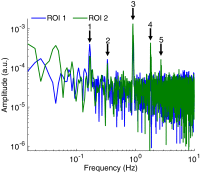Intraoperative video-rate hemodynamic response assessment in human cortex using snapshot hyperspectral optical imaging
- PMID: 27752519
- PMCID: PMC5061108
- DOI: 10.1117/1.NPh.3.4.045003
Intraoperative video-rate hemodynamic response assessment in human cortex using snapshot hyperspectral optical imaging
Abstract
Using light, we are able to visualize the hemodynamic behavior of the brain to better understand neurovascular coupling and cerebral metabolism. In vivo optical imaging of tissue using endogenous chromophores necessitates spectroscopic detection to ensure molecular specificity as well as sufficiently high imaging speed and signal-to-noise ratio, to allow dynamic physiological changes to be captured, isolated, and used as surrogate of pathophysiological processes. An optical imaging system is introduced using a 16-bands on-chip hyperspectral camera. Using this system, we show that up to three dyes can be imaged and quantified in a tissue phantom at video-rate through the optics of a surgical microscope. In vivo human patient data are presented demonstrating brain hemodynamic response can be measured intraoperatively with molecular specificity at high speed.
Keywords: epilepsy; hemodynamic response; hyperspectral imaging; intraoperative imaging.
Figures








References
LinkOut - more resources
Full Text Sources
Other Literature Sources

